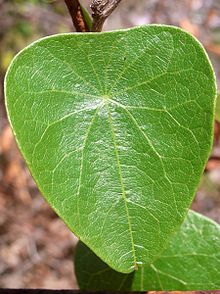Stephania japonica, known as snake vine,[2] is a vine often seen in sheltered areas near the sea.
| Snake vine | |
|---|---|

| |
| Snake vine at Palm Beach, Australia | |
| Scientific classification | |
| Kingdom: | Plantae |
| Clade: | Tracheophytes |
| Clade: | Angiosperms |
| Clade: | Eudicots |
| Order: | Ranunculales |
| Family: | Menispermaceae |
| Genus: | Stephania |
| Species: | S. japonica
|
| Binomial name | |
| Stephania japonica | |
| Synonyms | |
| |

Description
editA dioecious vine without prickles. Greenish small flowers form on compound umbels, growing from the leaf axils in the warmer months. Inflorescences are 4 to 8 cm long. The fruit is an oval shaped, orange or red drupe, 2 to 5 mm long. A feature of this plant is the peltate leaves, (the stem is attached to the leaf, away from the leaf edge).
Distribution
editA widespread vine seen as far south as Eden, New South Wales, north through Queensland. Also seen in Japan, India, Nepal, and many other areas of south-east Asia and the Pacific region. The original specimen was collected in Japan, hence the specific epithet “japonica”.[3] The variety in New South Wales is known as bicolor, as the under-side of the leaf is somewhat paler than above.
Chemistry
editProtostephanine is an alkaloid collected from Stephania japonica (Menispermaceae). Antihypertensive agent.
Consumption
editThe leaves of this plant are commonly used to produce edible green grass jelly in Indonesia.[4]
References
edit- ^ Walp. 1842. Repert. Bot. Syst. (Walpers) 1: 96 .
- ^ English Names for Korean Native Plants (PDF). Pocheon: Korea National Arboretum. 2015. p. 647. ISBN 978-89-97450-98-5. Archived from the original (PDF) on 25 May 2017. Retrieved 4 January 2017 – via Korea Forest Service.
- ^ Les Robinson - Field Guide to the Native Plants of Sydney, ISBN 978-0-7318-1211-0 page 336
- ^ http://digilib.unila.ac.id/5662/9/Bab%202%20.pdf Detection of Coliform Bacteria in Traditional Snacks Black Cincau at Traditional Market and Supermarket in Bandar Lampung City